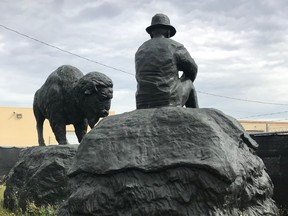The government estimates resuming indexation will save Albertans $304 million in 2022-23, $680 million in 2023-24 and $980 million in 2024-25
Author of the article: Ashley Joannou
Publishing date: Aug 31, 2022 •

The Alberta government released its first quarter fiscal update on Wednesday, confirming that high resource revenues mean a jump in the expected surplus. But while the windfall means Alberta will go back to indexing personal income tax rates, similar changes are not on the books for supports for seniors or AISH.
Finance Minister Jason Nixon unveiled the official document at a news conference Wednesday. It shows that Alberta’s surplus increased to a forecasted $13.2 billion for 2022-23, money which the government plans to use to help repay $13.4 billion in debt that comes due this fiscal year, the largest single-year debt repayment in Alberta’s history.
As was first announced Tuesday by Premier Jason Kenney, Alberta is also reindexing income taxes to inflation, retroactive to the 2022 tax year after de-indexing the system in 2019. A recent study by the University of Calgary’s School of Public Policy says the move effectively forced Albertans to pay almost $647 million more in taxes from 2020 to 2022.
The basic personal tax amount is rising to $19,814. The government estimates resuming indexation will save Albertans $304 million in 2022-23, $680 million in 2023-24 and $980 million in 2024-25.

Alberta government commits to improving AISH appeals, while advocate calls separate rule change 'disturbing'
But Nixon confirmed Wednesday that supports for seniors and AISH, also de-indexed in 2019, will not be getting the same treatment. He said Alberta already has the most generous social services programs anywhere in the countr
“We remain utterly committed to having the strongest social service programs and AISH is extremely important to Albertans, and particularly to Albertans that are on AISH,” he said.
AISH was first indexed to inflation under the NDP government in late 2018. When the UCP government took power the next year that decision was reversed. At the time, the government said the move would save more than $300 million by 2023 and was necessary to keep the program sustainable.
The move has continued to draw heavy criticism because without indexation, payments do not go up with the rising cost of living.
At a news conference Wednesday, NDP MLA Kathleen Ganley said the government’s decision not to reindex AISH, the child tax benefit or the seniors benefit is “just plain cruel.”
“We have a situation in this province right now where we have record revenues coming in, where we have billions in surplus, and this government is allowing children and seniors and disabled Albertans to continue to struggle to pay for food,” she said.
Nixon said legislation will have to be passed in the fall to officially reindex personal income tax but that the government will be sending a letter to the federal government to make its intention clear.
WTI projected to average US$92.50
According to the fiscal update, the province’s revenue forecast for 2022-23 is $75.9 billion, $13.3 billion higher than reported in the February budget. That’s due mainly to higher-than-expected oil and gas revenue. In the original budget, officials estimated that the cost of West Texas Intermediate (WTI) crude would average US$70 a barrel. Instead, the price of a barrel sat well beyond that, hitting US$120 a barrel in early June.
The new estimates project that WTI will average US$92.50 for the year.
The $28.4 billion expected to come in through resource revenue in 2022-23 is the highest on record, Nixon said.
The government is also making the largest ever single-year investment in the Heritage Savings Trust Fund — a total of just under $3 billion.
“By reducing the provincial debt Alberta’s government is taking the interest burden off of future generations,” he said.
“By Investing in the Alberta Heritage Saving Trust Fund Alberta’s government is growing a source of financial strength to increase our ability to deal with the inevitable economic ups and downs.”
Total expenses in the fiscal update are forecast at $62.7 billion, up slightly from the $62.1 billion estimated at budget.
The increase is caused in part by $279 million in federal funding for the Site Rehabilitation Program that is being spent this year instead of next year and an estimated $277 million needed to cover the cost of selling oil due to higher prices and volumes, according to the document.
Taxpayer-supported debt is forecast at $79.8 billion on March 31, 2023, which is $10.4 billion lower than estimated in the budget. By the end of the fiscal year the net debt-to-GDP ratio is estimated at 10.3 per cent.
ajoannou@postmedia.com
twitter.com/ashleyjoannou














 It was a good start on a long road to reconciliation with Aboriginal peoples, but we were discarded in favour of a Wicihitowin process which was primarily led by Mr. Lewis Cardinal. Despite a lot of unfinished business, nothing has happened since that time. Consultations with a privileged few while avoiding the most knowledgeable, simply has not worked. As a Metis who has lived and worked with Indigenous people my whole life, I wish to say that reconciliation needs to be seen to be done and the Rossdale Flats is an ideal location to reimagine our relationship with First Peoples.
It was a good start on a long road to reconciliation with Aboriginal peoples, but we were discarded in favour of a Wicihitowin process which was primarily led by Mr. Lewis Cardinal. Despite a lot of unfinished business, nothing has happened since that time. Consultations with a privileged few while avoiding the most knowledgeable, simply has not worked. As a Metis who has lived and worked with Indigenous people my whole life, I wish to say that reconciliation needs to be seen to be done and the Rossdale Flats is an ideal location to reimagine our relationship with First Peoples.